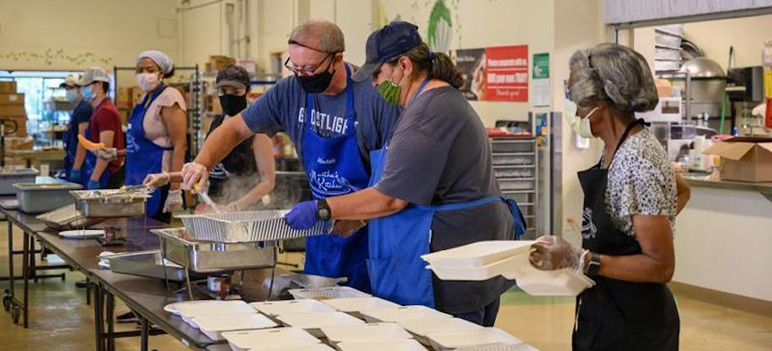As the coronavirus exacts a growing economic toll, Bay Area food banks and soup kitchens face the triple challenge of raising funds to meet increased demand, attracting new volunteers and distributing food under safe conditions.
Yet, faced with record numbers of people suffering food insecurity, the free food distributors are doing a remarkable job, gearing up successfully to provide more food and prepared meals to needy residents.
Loaves & Fishes Family Kitchen, for example, has nearly tripled the number of meals it provides each day. “Since March our meals have gone from 2,500 a day to 7,000,” said Gisela Bushey, CEO of the 40-year-old nonprofit that serves prepared meals to homeless, extremely low-income families, children, senior citizens, veterans and disabled people in Santa Clara and San Mateo counties.
“Because we are an essential services organization, we have remained open the entire time,” Bushey said in a recent interview.
The picture is similar at Second Harvest of Silicon Valley, one of the nation’s largest food banks, which reports it now serves a staggering half-million people from its food distribution center. And San Jose nonprofit Martha’s Kitchen says the number of meals it serves each month has roughly doubled.
“We’re probably serving 40,000 more meals a month than we were,” said Kevin Patterson, a manager at Martha’s Kitchen, which has been in operation since 1981.
As demand for food increases, so do the costs of providing it. “Since the pandemic, we are providing double the amount of food to double the number of people—and it’s at double the cost,” Second Harvest spokeswoman Diane Baker Hayward said.
Yet, food distributors say they largely have been able to fund the additional food and associated expenses, thanks to the growing generosity of donors.
“[The] majority of the funds we operate on are from individuals like you and me who write checks,” Baker Hayward said.
And along with donations, free food distributors also rely on creative relationships with farmers and local businesses. “Since the pandemic, we have had to find additional bulk resources,” Bushey said. “We developed partnerships with restaurants, some of the farms in the Central Valley, Costco, Grocery Outlet, Starbucks—all of whom provide us with food, [including] prepared food.”
Under Covid-19 conditions, food banks face the additional challenge of keeping employees, volunteers and consumers safe while sorting, preparing and distributing food.
“Now we are 6 feet apart, we wear masks, we are cleaning constantly,” said Baker Hayward at Second Harvest. “We temperature everybody, we ask them to wash their hands the moment they come into our building, we sanitize them, then we glove them,” said Bushey at Loaves & Fishes.
Distribution methods have also evolved.
Second Harvest not only donates food to partner organizations like Loaves & Fishes, it also hands out uncooked food items directly to the public.
“We had to change those farmer market styles, and we adopted drive-thru distributions,” Baker Hayward said, noting that Second Harvest now has 150 drive-thru distributions, with some of them serving more than 1,000 people each time. “Everything all of a sudden had to go in boxes—pre-picked, pre-sorted.”
“Unfortunately,” Bushey said, “at our meals service sites where before we would serve meals, have people stay and enjoy their meals there—with Covid we can only distribute meals individually.”
Despite all the changes, Bushey said Loaves & Fishes adheres to high standards for nutritional quality. The nonprofit has volunteer nutritionists who review menus, and its lead chef has a background in nutrition.
“The majority of the folks we serve, the one meal we get to them each day is the only meal they are going to get that day,” she said. “We always strive for 100 percent of the daily nutritional requirements.”
None of the work food banks do would be possible without a large volunteer force, and initially Covid-19 took its toll here, as well. “Prior to the pandemic we would have about 5,000 volunteers here,” Bushey said. “When the shelter-in-place [order] went into effect in March, our volunteer base went down to zero.”
Since then, however, volunteers have slowly trickled back.
“Getting volunteers back was a slow process, [and] we have still really struggled to get them in,” Baker Hayward said. “We brought back volunteers in a different capacity. We can’t have as many bunched together, so they are spaced out.”
But while many of the volunteers that once helped Martha’s Kitchen have stopped serving because they are at-risk, Patterson said an infusion of new people has kept volunteer levels the same. “Our older volunteers did stop coming in,” Patterson said, “but now we have plenty of new, younger volunteers.”
On balance, the combination of creative approaches to the food crisis and community support for food banks offers the hope that free food distribution will continue to be available to a growing number of those in need. “We really want people to know that’s what we are here for,” Baker Hayward said. “It’s not easy for people to ask for help, so we want them to know it’s OK—especially right now.”

